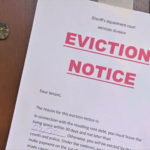A reference of Virginia eviction laws, and steps of the Virginia eviction process for landlords and renters, updated 2021.
- What are the reasons that landlords can evict tenants under Virginia eviction laws?
- Nonpayment of rent (Va. Code Ann. § 55.1-1245(F))
- Threat to health or safety (Va. Code Ann. § 55.1-1245(B))
- Illegal activity (Va. Code Ann. § 55.1-1245(B))
- Curable non-compliance with the lease agreement (Va. Code Ann. § 55.1-1245(A))
- Uncurable non-compliance with the lease agreement (Va. Code Ann. § 55.1-1245(C))
- Tenant remains in possession of the rental unit after the lease term without the owner’s permission (Va. Code Ann. § 55.1-1253(A))
- What notice do Virginia eviction laws require that landlords provide tenants before starting the eviction process?
- For evictions based on non-payment of rent, the landlord must provide a 14-day notice. (Va. Code Ann. § 55.1-1245(F)).
- For evictions based on a curable material noncompliance that materially affects health and safety, the landlord must provide a 30-day notice that states the acts or omissions constituting the breach and stating that the rental agreement will terminate no sooner than 30 days from the date the notice is received if the breach is not remedied in 21 days. (Va. Code Ann. § 55.1-1245(A)). If the breach can be cured by repairs, payment of damages, or other means and the tenant adequately remedies it before 21 days, the lease does not terminate. (Va. Code Ann. § 55.1-1245(B)). If the tenant breaches the lease again in a similar manner, the landlord can issue a 30-day written notice to the tenant and the tenant will not have the opportunity to remedy the breach. (Va. Code Ann. § 55.1-1245(E)).
- For a material, incurable breach of the lease agreement, the landlord must serve a 30-day notice to the tenants that specifies the acts and omissions constituting the breach. (Va. Code Ann. § 55.1-1245(C)).
- For evictions based on a criminal or willful act that is not remediable and that poses a threat to health or safety, the landlord can immediately terminate the lease agreement and begin the eviction process. (Va. Code Ann. § 55.1-1245(C)).
- There are special rules and procedures that apply if the landlord owns more than four rental dwelling units.
- For evictions based on remaining in possession of the rental unit beyond the period of the lease without the owner’s permission, the landlord must provide a 7-day notice to end a wee-to-week notice or a 30-day notice to end a month-to-month notice. If the tenant remains in possession of the rental property beyond the term of occupation, the landlord can bring an action for possession and recover actual damages, court costs, reasonable attorney’s fees, and a reasonable liquidated damage penalty for each day the tenant remains in possession if that clause is included in the rental unit. (Va. Code Ann. § 55.1-1253(A)).
- Do Virginia eviction laws allow landlords to use “self-help eviction” methods, such as locking a tenant out of the rental unit or shutting off the utilities?
- No. Virginia law prohibits self-help measures.
Virginia Eviction Process: Step-by-Step
The eviction process in Virginia involves the following six-step process:
- The landlord serves the eviction notice. The landlord must give the tenant the appropriate eviction notice. The landlord cannot take any further action until the deadline specified in the notice expires.
- The landlord files an eviction lawsuit. If the tenant fails to move out after receiving the eviction notice or cure the breach, the landlord can begin the official eviction process in Virginia by filing an eviction action in the General District Court – Civil Division. The landlord files an Unlawful Detainer Action. The landlord must also have a Summon for Unlawful Detainer issued that states that there is a pending case against the tenant. The court sets a hearing date for within 30 days.
- The tenant answers. The landlord is responsible for having the tenant legally served with the Complaint and Summons. The tenant can prepare a written answer in response to the lawsuit.
- The parties attend the hearing. The parties attend the court hearing and present their case.
- The landlord files a writ of possession. If the tenant does not appear at the hearing or the court rules in favor of the landlord, the landlord must file a Writ of Possession.
- The landlord gives the sheriff the writ of possession. Once the court grants the writ of possession, it will give it to the sheriff’s office. The tenant has 72 hours to leave on their own before the sheriff forcibly removes them from the property.







